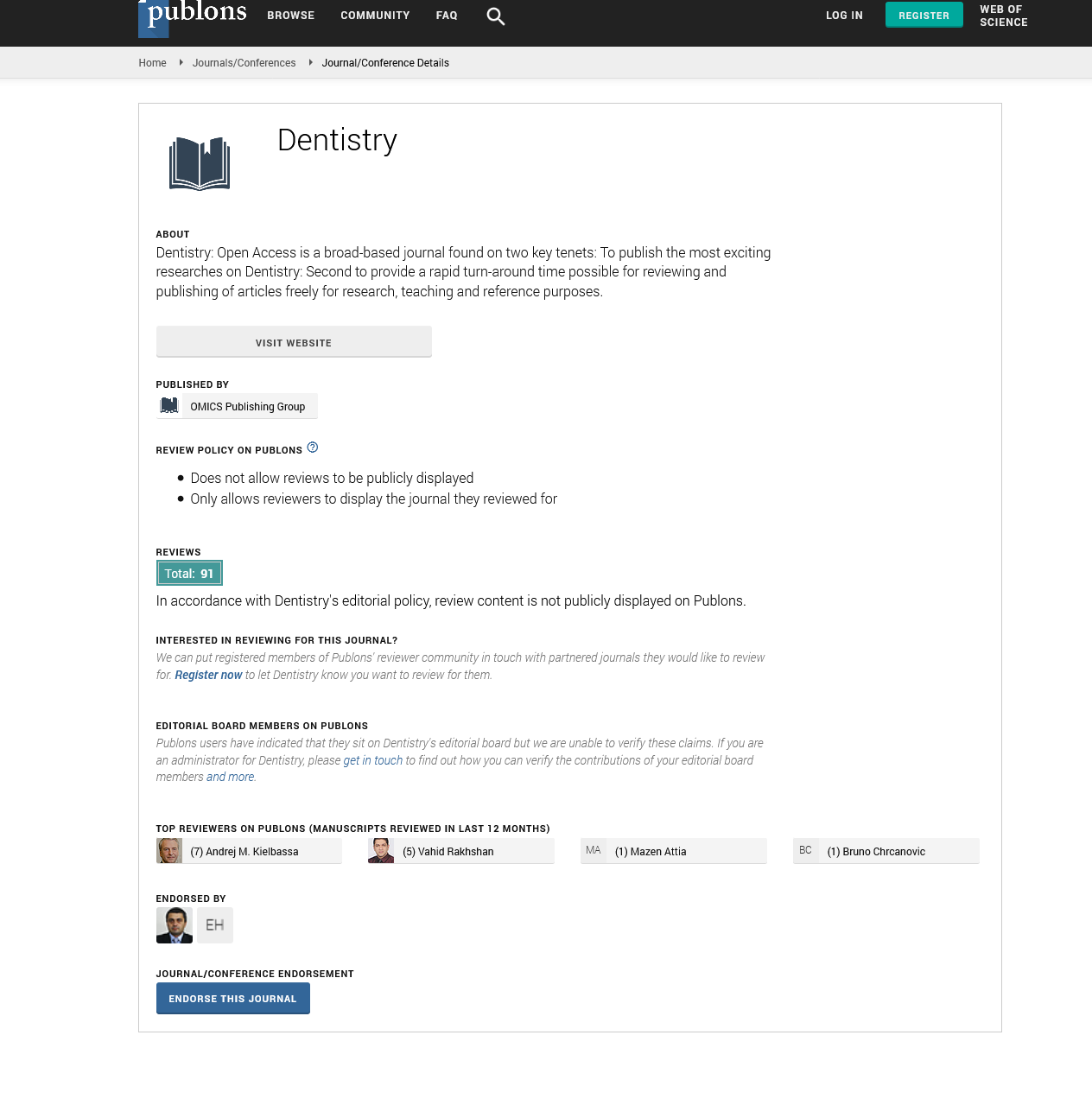Citations : 2345
Dentistry received 2345 citations as per Google Scholar report
Indexed In
- Genamics JournalSeek
- JournalTOCs
- CiteFactor
- Ulrich's Periodicals Directory
- RefSeek
- Hamdard University
- EBSCO A-Z
- Directory of Abstract Indexing for Journals
- OCLC- WorldCat
- Publons
- Geneva Foundation for Medical Education and Research
- Euro Pub
- Google Scholar
Useful Links
Share This Page
Journal Flyer

Open Access Journals
- Agri and Aquaculture
- Biochemistry
- Bioinformatics & Systems Biology
- Business & Management
- Chemistry
- Clinical Sciences
- Engineering
- Food & Nutrition
- General Science
- Genetics & Molecular Biology
- Immunology & Microbiology
- Medical Sciences
- Neuroscience & Psychology
- Nursing & Health Care
- Pharmaceutical Sciences
Commentary - (2023) Volume 13, Issue 1
Virtual and Real Microscopy Uses of a Dental Study
Smith Murray*Received: 02-Jan-2023, Manuscript No. DCR-23-19871; Editor assigned: 05-Jan-2023, Pre QC No. DCR-23-19871 (PQ); Reviewed: 19-Jan-2023, QC No. DCR-23-19871; Revised: 26-Jan-2023, Manuscript No. DCR-23-19871 (R); Published: 03-Feb-2023, DOI: 10.35248/2161-1122.23.13.618
About the Study
Virtual microscopy has been used for learning and teaching histology and pathology laboratory course for more than 10 years. This study aimed to compare the learning outcome of virtual microscopy with that of real light microscopy in oral histology laboratory course among dental patients. Dental Patient-Reported Outcome Measures (DPROM) can be divided into measurements for specific oral diseases and outcomes for all oral disorders, referred to as disease-specific DPROMs. The purpose of this systematic review was to pinpoint the Dental Patient-Reported Outcomes (DPROs) for adult patients that were psychometrically validated to be non-malignant diseasespecific DPROMs.
Since digitised virtual slides are widely used in many fields. The introduction of a virtual microscopy system into the oral histology and oral pathology curricula has already demonstrated that students in both the dentistry and general medical programmes preferred virtual histology slides to "traditional" glass slides. Oral histology is one of the required studies for dentistry students in their first year, and its primary goal is to help students comprehend the microanatomy of oral structures and the relationship between those structures and their functions. Oral histology classes often involve in-person lectures and the light microscopy examination of oral tissue slices on glass slides. However, the acquisition and maintenance costs for a genuine light microscope and conventional glass slides are high. A few years later, the stained tissue sections on the glass slides may begin to fade in colour, necessitating the replacement of the old, failing glass slides. In the school lab, studying the glass slides with tissue sections under a light microscope should also be done. Therefore, it appears that real light microscopy using conventional glass slides has a lot of constraint.
Dental students can learn to identify oral structures and make connections to their functions with the use of microscopic slides of mouth tissue sections. In the past, oral histology laboratory classes tended to use light microscopy with a glass slide set. However, there are many drawbacks to light microscopy, including high costs for the purchase and upkeep of microscopes. The stained tissue sections on the glass slides may fade in colour, which could be detrimental to understanding microscopic features.
The virtual microscopy system was created as a result of advances in computer technology and is now used in a variety of fields, including histology and pathology classes, resident training programmes, and clinical use in the pathological department for routine diagnoses of surgical or biopsy specimens. The virtual microscopy system has a number of benefits, including improved image quality, ease of handling for publication and consultation, effective use of virtual slides during the practise of laboratory histopathological diagnosis, and convenient access to the virtual slides anywhere there is a computer and an internet connection.
All of the aforementioned benefits appear to be able to outweigh the drawbacks of real light microscopy on conventional glass slides. In this study, we discovered that dental students preferred virtual microscopy over light microscopy across all six items (all P-values 0.01), including whether the operation method is desirable, whether the learning system's navigation causes any inconvenience, whether the type of microscope and slide is easy to view, whether the teaching method is effective, and whether this teaching method is useful for learning oral histology. Furthermore, it was found that dental students who used virtual microscopy and digitised virtual slides frequently had a considerably higher proficiency in histological diagnosis than those who used light microscopy and conventional glass slides (P 0.001). They recruited over 400 fully digitized virtual slides which covering 15 entities in basic and systemic pathology as well as 15 entities in oral pathology. The virtual microscopy as a didactic tool was rated over 8 on a 10-point scale for basic and systemic pathology and 9 for oral pathology especially.
Citation: Murray S (2023) Virtual and Real Microscopy Uses of a Dental Study. J Dentistry. 13:618.
Copyright: © 2023 Murray S. This is an open access article distributed under the terms of the Creative Commons Attribution License, which permits unrestricted use, distribution, and reproduction in any medium, provided the original author and source are credited.

